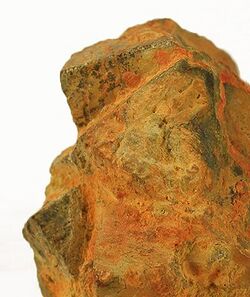Chemistry:Masuyite
From HandWiki
| Masuyite | |
|---|---|
 Orange Masuyite coating crystals of cubic uraninite (to about 1 cm). Shinkolobwe mine, the type locality, Democratic Republic of the Congo. | |
| General | |
| Category | Oxide minerals |
| Formula (repeating unit) | Pb[(UO2)3O3(OH)2]·3H2O |
| Strunz classification | 4.GB.35 |
| Crystal system | Monoclinic |
| Crystal class | Domatic (m) (same H-M symbol) |
| Space group | Pn |
| Unit cell | a = 13.98 Å, b = 12.11 Å, c = 14.2 Å; Z = 2 |
| Identification | |
| Optical properties | Biaxial (-) |
| Refractive index | nα = 1.785 nβ = 1.895 nγ = 1.915 |
| Birefringence | δ = 0.130 |
| 2V angle | Measured: 50° , calculated: 44° |
| Dispersion | extreme |
| Other characteristics | |
| References | Masuyite on Mineralienatlas[1] |
Masuyite is a uranium/lead oxide mineral with formula Pb[(UO2)3O3(OH)2]·3H2O.[3]
Masuyite was first described in 1947 for an occurrence in Katanga and named to honor Belgian geologist Gustave Masuy (1905–1945).[4]
See also
- Classification of minerals
- List of minerals
References
- ↑ Mineralienatlas
- ↑ Warr, L.N. (2021). "IMA–CNMNC approved mineral symbols". Mineralogical Magazine 85 (3): 291–320. doi:10.1180/mgm.2021.43. Bibcode: 2021MinM...85..291W.
- ↑ Webmineral
- ↑ Handbook of Mineralogy
 |

